The 16th Annual Report of Federculture (“From the Time of Care to the Time of Revival”), which photographs the situation of culture in 2020, was presented this morning. It was introduced by Federculture President Andrea Cancellato, who reminded how the Ministry of Cultural Heritage and Activities and Tourism should be an important economic and social player in the life of the country. “Minister Franceschini,” said Cancellato, “used to say that MiBACT was the biggest economic ministry in Italy. Today MiBACT must become the most important ministry of the new Italian welfare, that is, the ministry that will make culture the key element of our living in community, and the most relevant factor of our education and recognition in the world.”
Cancellato then pointed to some of the interventions that will need to be put in place in the future: the implementation of the indications of the 2018 budget law on creative cultural enterprises, which was suspended at the beginning of the pandemic; the mobilization of all available resources, public and private to support culture by extending tax breaks (such as the Art Bonus); the inclusion, already present in European programs, of theinfrastructural adaptation of all cultural venues (theaters, libraries, museums, and so on), so as to make them welcoming to the public and more energy efficient; and a campaign to digitize all the archival heritage of our institutions.
Turning to the reading of the data presented by Umberto Croppi, director of Federculture, we can begin by noting that although the pandemic has hit the sector very hard, the findings indicate that some trends were not positive in themselves. The first point to note is the fact that MiBACT is the only public body to have increased spending between 2000 and 2018, by 11 percent (from 2.398 billion in 2000 to 2.652 billion in 2018), compared with municipalities, which decreased it by 27 percent (from 2.745 in 2000 to 2,001 in 2018), the regions marking a -23 percent (1,017 versus 1,324), and the provinces that have almost reduced it to zero, since they have been eliminated, except for a few surviving institutions (-82 percent, from 276 million in 2000 to 49 million in 2018). Thus, there has been a significant reduction in public resources for the cultural sector: the only spending to hold is state spending. From 2000 to 2018, public spending on culture, pulling the numbers together, lost 1 billion euros, from 6.7 billion in 2000 to 5.7 billion in 2018.
In parallel, there has been a contraction in cultural demand since 2010, although it is important to note that museums, exhibitions, archaeological sites and monuments are the only places of culture that have always grown, without setbacks. For cinema, theater, and concerts, in fact, there was a contraction of people between 2010 and 2019, which was not the case for museums and exhibitions, which have always been growing steadily since 2001 (so much so that the number of visitors to state museums has significantly increased: from 30,175,826 in 2000 to 54,798,092 in 2019, almost a doubling). Cinema up to 2010 was growing by 12.1 percent, but since 2010 it has lost 6.1 percent of moviegoers. Again, theater between 2010 and 2019 saw an 8.8 percent decline, and in previous years had grown by 27.3 percent. Similar trends were also seen for classical and light music concert attendees, which declined by 4.9 percent and 4.7 percent respectively in the last ten years under consideration (2010-2019), while they grew by 22.5 percent and 19.6 percent in the previous decade. The contraction then also affects reading: Italy, between 2010 and 2019, marked a -13.4 percent of people aged six and older who read at least one book per year, with a strong territorial imbalance, as it is -11 percent for the Northwest, -8.3 percent for the Northeast, -14.1 percent for the Center, and even -19.5 percent for the South and -21.1 percent for the islands.
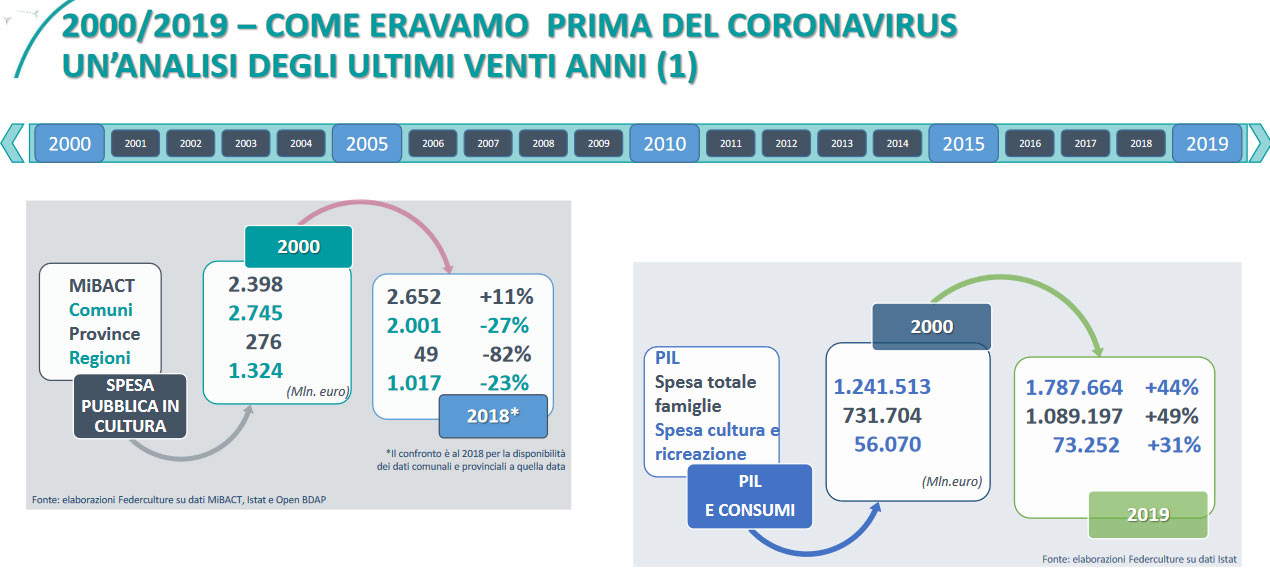 |
| Public spending on culture and household spending on culture |
 |
| Trends in cultural enjoyment |
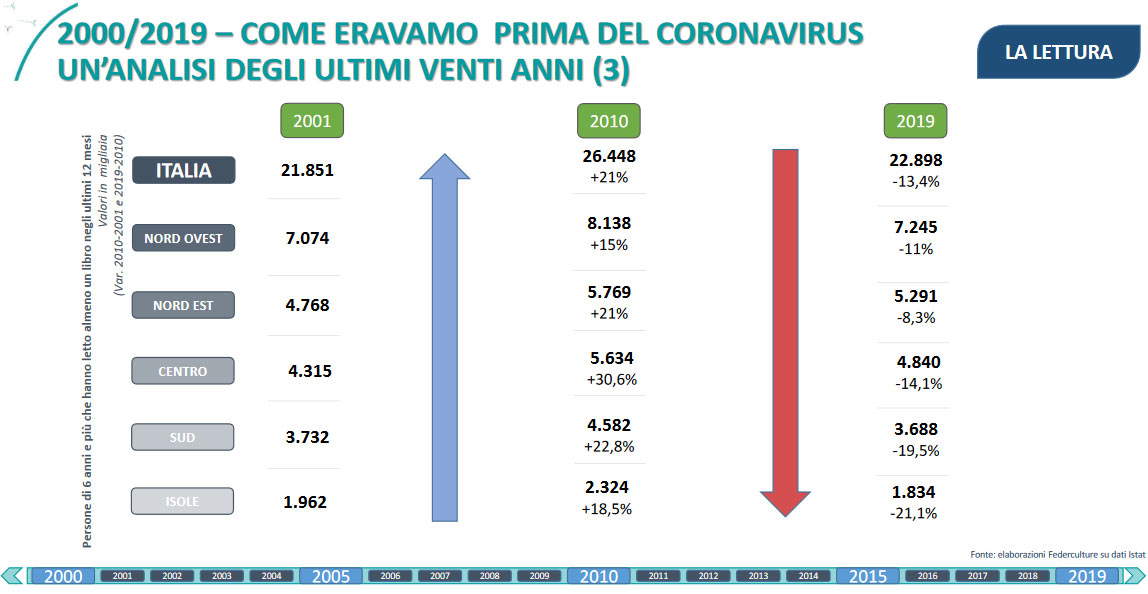 |
| Trends in reading |
 |
| Trends in visitors to state museums |
For Croppi, the increase is due to MiBACT’s investments, which were mainly in the museum sector. “If we compare the figure with respect to the beginning of the millennium,” Croppi said, “there is an increase in spending, but with a curve that gives one pause for thought, because while there was a strong increase in the first decade, at the turn of 2010 a downward phase began, so we record in the decade for theater a loss of almost 9 percent, for cinema 6 percent, for classical music concerts about 5 percent, and the same for other concerts. On the rise are only museums, exhibitions and archaeological sites and monuments. And here I limit myself to a single reflection because the data is sginificative: in the face of a decrease in the last ten years of a general fruition of almost all cultural institutions increase instead both the number of presences and the economic revenue from the fruition of museums and archaeological sites, because the investments that MiBACT has made, both in economic terms and in the improvement in the change of management logics through the establishment of museums with a degree of autonomy, through restructuring superintendencies, evidently have shown that a focus on the level of governance and economic investments produce results. So we are led to say that if as much attention can be given in the coming years to the other sectors of culture, the prospects dci growth are remarkable.”
The Federculture Report, which analyzes twenty years of legislative production, highlights how the reform policy of the museum sector from 2000 to the present, starting with the birth of the Foundations and through setbacks and forward momentum, has changed the management policies of culture toward greater autonomy, which today, not only because of the contingent emergency, appears to be challenged. It is precisely on these changes that the current phase of crisis, which has impacted culture very heavily, is imparting anacceleration. The sector must come to terms with totally changed scenarios and an impossible return to pre-crisis normality, at least in the medium term. Therefore, even for culture businesses it is necessary to rethink production models, sustainability conditions, the relationship with audiences, and the way content and visitor experiences are offered and enjoyed.
“As is clear from all the speeches published in the volume,” Croppi said, “there is an indication that concerns precisely the effects of the crisis, which, beyond the very serious losses of turnover and users that we will see, have highlighted problems that were latent and structural, which the crisis situation has only highlighted, and which therefore impose on us the need to proceed to a basic revision, in perspective, of management models.” The coronavirus crisis has impacted very severely: during the lockdown, 90 percent of those surveyed totally or partially halted their activities, and only 17 percent resumed operations on the day of reopenings, May 18. Moreover, 70% of respondents expect economic losses of up to 40% of the budget, while 13% even think that losses will exceed 60%.
Part of the XVI Report then deals with the impact of the economic crisis triggered by the Covid-19 pandemic. The survey covered several sectors: the world of exhibitions and museums (44 percent of responses), entertainment (41 percent), cultural services (20 percent), education (20 percent), libraries and publishing (19 percent), and land promotion and tourism (13 percent). As for the type of the sample, 52 percent are foundations, 22 percent associations, 7 percent public administrations, 6 percent businesses and 13 percent other entities. They are distributed 48% in the North, 43% in the Center and 9% in the South and islands. The entities that were the subject of Federculture’s research collectively reach 13 million people (including museum visitors, spectators, users of libraries and other cultural services, and students), and count a workforce that, between employees and collaborators, totals 6,120 workers. However, even in a scenario that is as unprecedented as it is difficult, many actors in the culture sector have reacted by conveying their traditional offerings in entirely new forms, including working in new ways (in smart working for l85 percent of institutions). In fact, virtually all cultural actors, 80-100% depending on the sector, offered remote services. The most popular is live broadcasting, implemented by 62.2% of respondents. This is followed by on-demand digital content such as web series and podcasts (57.8%), virtual tours (53.3%), online education for younger children or schools (46.7%), and online training programs (40%). In contrast, only 13.3 percent have activated digital services.
The positive finding is that many intend to continue offering these services to the public. In essence, what at a critical moment began as a supplementary offer compared to the ordinary, was soon perceived as an alternative offer or, better yet, as an additional declination of the canonical ways of enjoying the cultural product. As many as 96 percent of the actors who have activated online services related to their activity declare, in fact, that they intend to keep them in their schedule even after the crisis is fully overcome and the hoped-for return to normality. However, the exit from the crisis will not be painless for everyone. Only 22 percent envision a return to normalcy, while 50 percent anticipate a reduction and redefinition of their activities, and as many as 73 percent fear a reduction in funding.
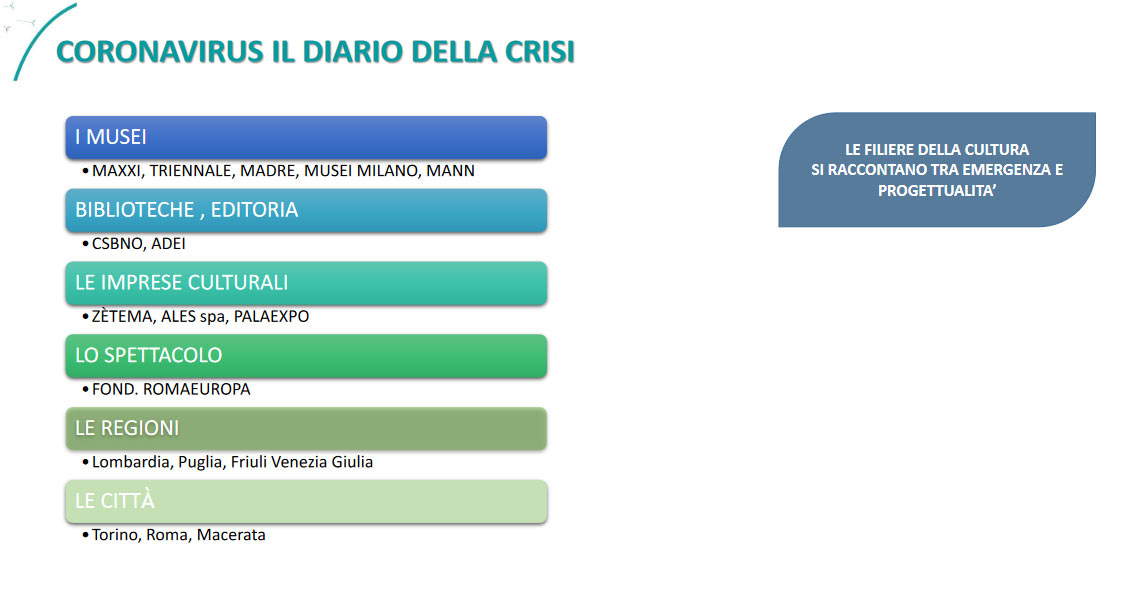 |
| Some of those who participated in Federculture’s survey. |
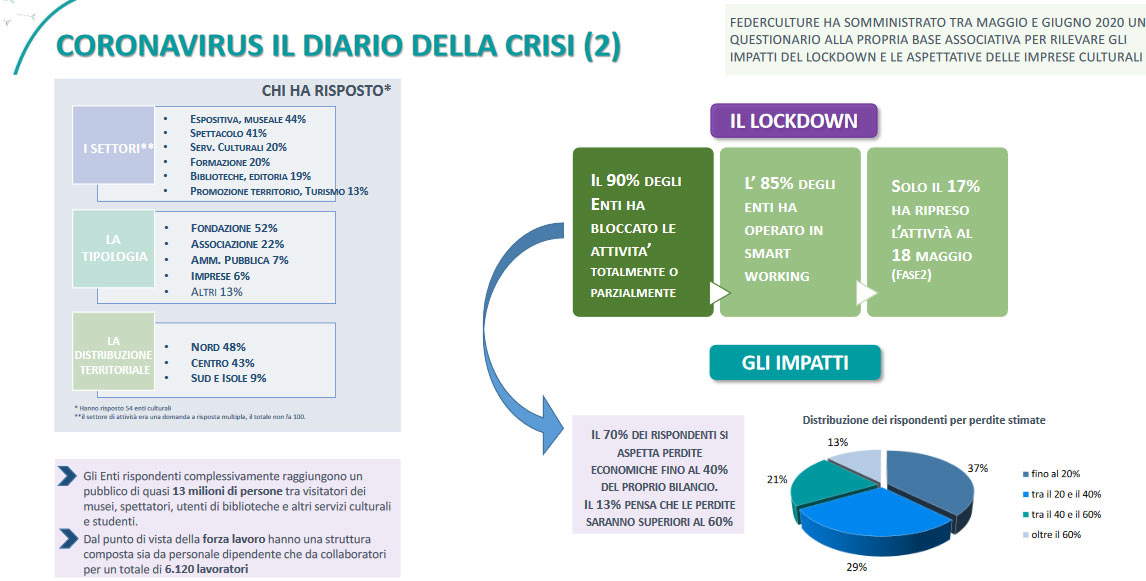 |
| Results of the survey on the impact of the coronavirus crisis on culture in Italy |
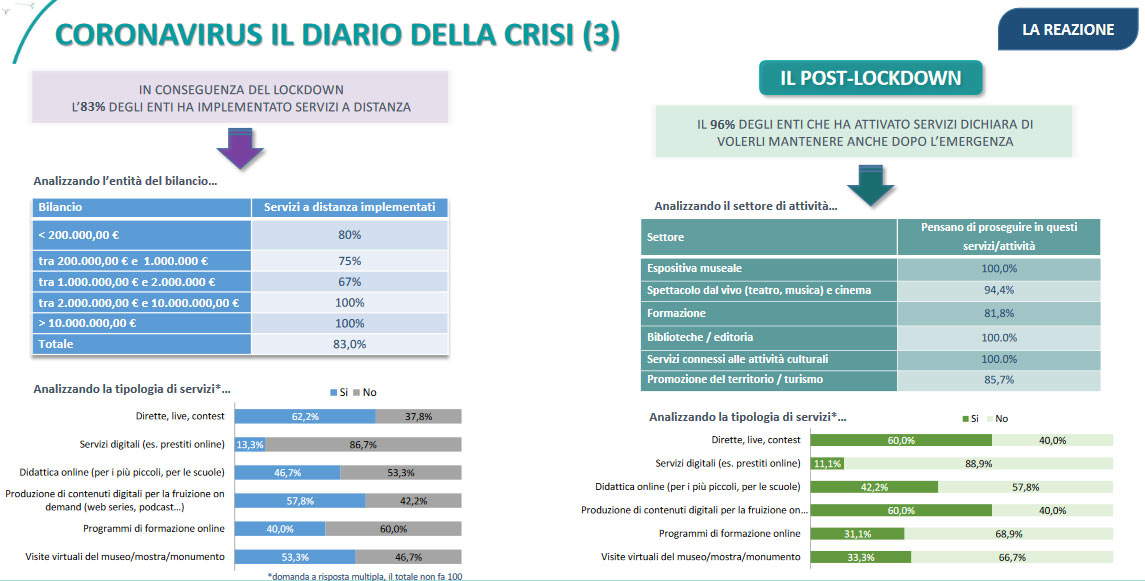 |
| Results of the survey on the impact of the coronavirus crisis on culture in Italy |
Therefore, despite uncertainties and difficulties, the culture sector inItaly marked by the Covid emergency has shown resilience in facing the crisis and confirms its value, the weight it has in the balance of the national economy, but above all the development potential it can still offer, urging the convinced and decisive choice of structural interventions. The protagonists of the sector themselves converge in pointing out the necessity and urgency of an alliance between all the players in the field, in order to relaunch the cultural sector and avert the danger that, once the buffer measures are exhausted, a downward spiral is triggered that could lead to the loss of an invaluable asset of social as well as economic value. It is therefore a matter of concretizing wide-ranging and prospective policies: developing innovative legal figures such as the cultural enterprise, defining and incentivizing virtuous forms of public-private partnership, experimenting with new and more efficient forms of sustainability and financing of public policies.
“Federculture,” concludes Andrea Cancellato, “has been on the front line in recent months with constant activity in monitoring the dynamics underway and working to provide answers to cultural enterprises so severely affected by the crisis. We have laid the groundwork for concrete interventions such as the Culture Fund, which, in the implementing decrees, we hope will be made accessible to the entire public and private cultural system. We think that with this and other tools the government should promote a major new investment, to which everyone should be able to contribute, in the cultural sector, which can be decisive in revitalizing the country that will emerge prostrate from the pandemic.” A final thought concerns theimportance of culture: “Culture,” Cancellato recalled in conclusion, “has been defined in this moment of crisis as an ancillary activity therefore absolutely not essential. We can also give up, as we are doing at this stage, many essential things, and among them is culture, because we are in a temporary phase of absolute emergency to which we must bow, but we must not and cannot think of culture as something additional, which can also be given up for the life of our communities.”
Pictured below: visitors to the Borghese Gallery on reopening day (ph. Credit Borghese Gallery)
 |
| Federculture 2020 report presented. Covid accentuated trends that were already negative (except for museums) |
Warning: the translation into English of the original Italian article was created using automatic tools. We undertake to review all articles, but we do not guarantee the total absence of inaccuracies in the translation due to the program. You can find the original by clicking on the ITA button. If you find any mistake,please contact us.